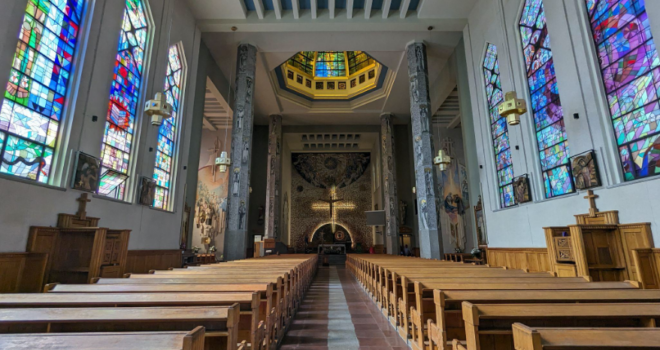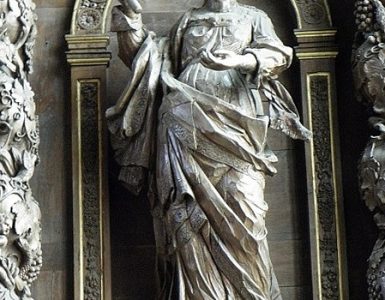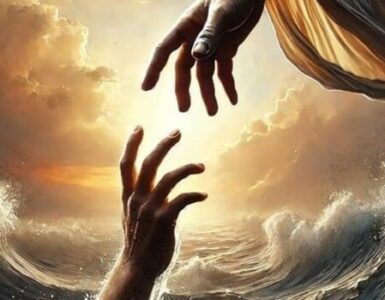In the Dębniki neighborhood of Kraków, tucked away from the hubbub of Old Town, tourists, and the bustling city streets, stands St. Stanisław Kostka Catholic Church. It’s a “new” church in Kraków’s history, built only in the early 1930s. However, it is truly a hidden gem. In its brief history, this parish has witnessed both immense tragedy during World War II and the forming of saints.

St. Stanisław Kostka in Kraków, Poland
In 1938, the young Karol Wojtyla, future Pope St. John Paul II, and his father began attending this Salesian parish. It was here that Karol Wojtyla’s priestly vocation was cultivated in large part by the example of a parishioner named Jan Tyranowski and the Salesian martyrs.
Venerable Jan Tyranowski was a thirty-nine-year-old unassuming tailor when Karol Wojtyla met him in 1940. He was a quiet man with a deeply devout faith that was formed by Carmelite spirituality and Marian theology. Jan’s life was changed in the pews of St. Stanisław Kostka years before when he heard a priest say, “it’s not difficult to be a saint.” Jan took these words to heart. His faithfulness to the call of sainthood greatly influenced the vocation of a future pope and saint.

In 1939, the Nazis invaded Poland. The nation was soon stained with the blood of millions as the Nazis committed genocide of Jews and the “cultural decapitation” of Poland, a phrase Alasdair Richardson’s uses in his book The Salesian Martyrs of Auschwitz.to describe the occupation of Poland. As part of this “cultural decapitation,” in which the Poles were to be slaves of the German world, Polish leaders of faith, academia, and politics were shot or “removed” to Gestapo prisons and concentration camps to reduce resistance and to demoralize the Poles.
“The Nazis introduced measures to severely restrict the practices and influence of religious life in Poland,” writes Richardson. They desired the “complete destruction of the Church organization and religious life.” A religious order founded to help youth in particular, the Salesians were a threat to the Nazis who sought to “limit religious practices and to keep future generations of ethnic Poles poorly educated and compliant.”
Despite the danger, the Salesian priests of St. Stanisław Kostka continued ministering to the youth of their parish. However, on May 23, 1941, the Salesian rectory adjacent to the church was overrun by Nazis. They arrested twelve priests, deporting them first to Montelupich Prison in Kraków and then to Auschwitz.
Around this time, Jan Tyranowski was asked to take charge of the faith formation of young men in the parish in the priests’ absence. Jan accepted. He organized clandestine Living Rosary groups in his home, and he could communicate Catholic doctrines to the young men, translating abstract ideas into living realties. He encouraged them to strive for holiness and hope, even as their native land was shadowed by Nazi flags. Under the threat of arrest and death, Jan invested in the souls of these young men, one of whom was Karol Wojtyla. Jan introduced Karol to Carmelite spirituality and the writings of saints such as St. Louis de Montfort and St. John of the Cross. This spiritual formation was life changing for Karol, as it was then that he began to discern the priesthood.
“In his words, in his spirituality, and in the example of a life given entirely to God, he represented a new world that I did not yet know,” Pope St. John Paul II wrote of Jan Tyranowski. “I saw the beauty of the soul opened up by grace.”
As Jan was engaged in the spiritual formation of young souls and Karol was beginning to awaken to his priestly vocation, the Salesian priests of St. Stanisław Kostka were assigned to hard labor in a penal company at Auschwitz-Birkenau. Every day was a fight to live. After one month at Auschwitz, only four of the twelve priests from St. Stanisław Kostka were alive. Among the surviving priests was Bl. Józef Kowalski.

Taken from his parish community, the death camp was Bl. Józef’s new mission field. He found ways to bring Christ’s love and hope to those around him by celebrating Masses, hearing confessions, comforting the dying, leading prayers, and encouraging his fellow prisoners to never give up, all of which was punishable in the camp. Despite receiving regular beatings for his pastoral ministry, Bl. Józef continued to serve God and others. According to Richardson, “He is also known to have organised services in honour of Mary with fellow prisoner Fr. Maximilian Kolbe.”

In the summer of 1942, after nearly a year of horror in the camp, Bl. Józef’s name was on a transport list for Dachau. However, as he was being searched in a bathhouse before leaving Auschwitz, an SS officer noticed that he was carrying a rosary and demanded that he trample on it. Bl. Józef refused. As punishment, Bl. Józef was taken off the transport list and assigned to another brutal penal company in Birkenau.
On July 3rd, 1942, Bl. Józef’s penal company was digging a drainage ditch when the SS soldiers and kapos (prisoner functionaries) began mocking him. A kapo pushed him into the filthy ditch as they continued to taunt him. He was ordered to stand on a barrel and give a sermon. “Bl. Józef ignored the taunts, knelt, made the sign of the cross and offered up his prayers with true devotion,” writes Richardson. An angered kapo knocked Bl. Józef from the barrel and beat him mercilessly.
That evening, Bl. Józef was taken from his block by a kapo. Moments before, he gave his last piece of bread to a fellow prisoner. “Pray for me and my persecutors,” he entreated. The kapo and the SS officer, who had ordered Bl. Józef to trample on the rosary, drowned him in a barrel of excrement in the early hours of July 4th, 1942. He was 31 years old. Bl. Józef Kowalski is among the 108 Blessed Martyrs of Poland beatified by Pope St. John Paul II in 1999.


Karol Wojtyla was ordained a priest on All Saints Day, November 1st, 1946. Two days later, he celebrated Mass at St. Stanisław Kostka. In 2002, he visited the parish during his last pilgrimage to his homeland as Pope, recounting the life changing impact of his local parish and its members.
“I always remember the Salesian Fathers who were removed from here to a concentration camp,” he said to the congregation. “Most of them never returned. I always remember them! I so remember the Living Rosary and Jan Tyranowski. To me they are all inextricably linked with Dębniki and with this church. With all my heart, I bless you, Salesians, pastors, and all Dębniki parishioners: in the Name of the Father, and the Son, and of the Holy Spirit. May the Lord bless you!”













